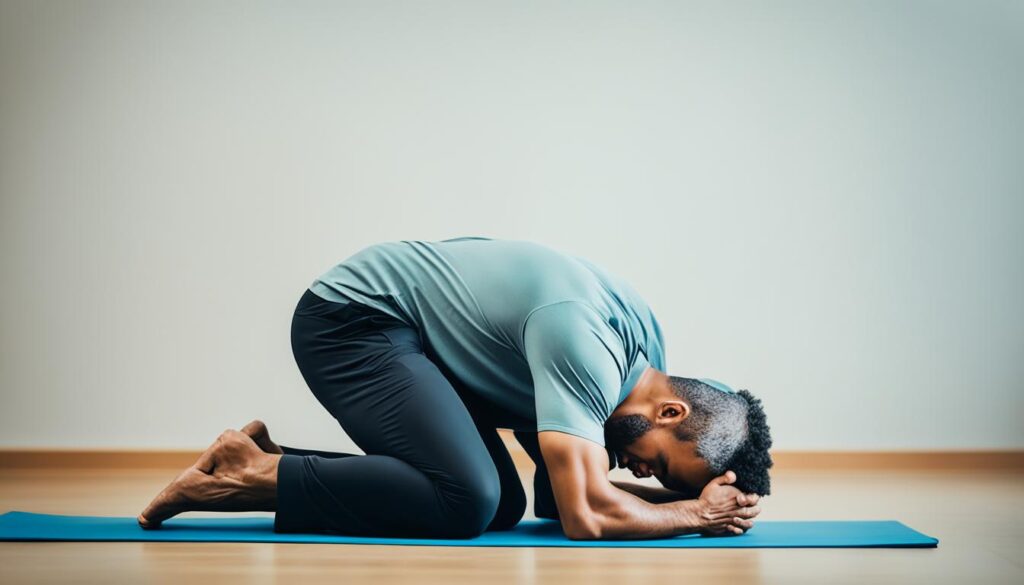Stress is a common problem for many individuals and can have a negative impact on their physical and mental well-being. While there are several stress relief techniques available, yoga has gained popularity as a safe and effective method for managing stress. Yoga is a physical, mental, and spiritual practice that originated in India and has been practiced for thousands of years. The benefits of yoga for stress relief are numerous.
Yoga promotes relaxation, reduces anxiety, and helps individuals manage stress more effectively. It is known for its ability to calm the mind, release tension in the body, and enhance overall well-being. Research has shown that regular yoga practice can lower cortisol levels, a hormone associated with stress, and reduce perceived stress levels. It can also improve mood, sleep quality, and overall quality of life.
Key Takeaways:
- Yoga is a safe and effective way to manage stress.
- Yoga promotes relaxation and reduces anxiety.
- Regular yoga practice can lower cortisol levels and reduce perceived stress levels.
- Yoga can improve mood, sleep quality, and overall quality of life.
- Incorporating yoga into a stress management routine can lead to long-term benefits.
Understanding the Connection Between Yoga and Stress Relief
Yoga has been used for centuries as a way to reduce stress and promote relaxation. Through a combination of physical poses, breathing exercises, and mindfulness techniques, yoga can help individuals manage anxiety and stress.
The practice of yoga can have a positive effect on the body’s physical response to stress. When an individual experiences stress, their body may respond with a “fight or flight” response that triggers the sympathetic nervous system. This response can lead to symptoms such as increased heart rate, rapid breathing, and tension in the muscles.
Yoga can help reverse these symptoms by activating the parasympathetic nervous system, which promotes relaxation and slows down the heart rate. This shift in the body’s response to stress can help individuals feel calmer and more relaxed.
Moreover, yoga encourages mindfulness – paying attention to the present moment – which can help individuals manage stress more effectively. Mindfulness can also help individuals shift their focus away from negative thoughts and feelings, reducing stress and increasing feelings of well-being.
Through the practice of yoga, individuals can also learn stress reduction techniques that can be applied in daily life. This can include breathing exercises, progressive muscle relaxation, and meditation.

Overall, practicing yoga offers a holistic approach to reducing stress and promoting overall well-being. By incorporating yoga into a stress management routine, individuals can learn techniques for managing stress and cultivating mindfulness that can have a positive impact on their physical and mental health.
Calming Yoga Poses for Stress Relief
To relieve stress, practicing yoga can be a great way to calm the mind and relax the body. Here we will discuss some specific yoga poses that can help promote relaxation and relieve stress.
1. Child’s Pose – This pose involves sitting back on your heels with your arms stretched out in front of you and your head resting on the mat. This pose helps to release tension in the lower back, hips, and thighs.

2. Cat-Cow Stretch – This pose involves moving through a gentle flow of inhaling while arching the back, and exhaling while rounding the spine. This pose can help to release tension in the neck, shoulders, and spine.
3. Pigeon Pose – This pose involves stretching one leg out behind you and bringing the other leg in front of you, bending it at the knee so that it is parallel to the mat. This pose can help to release tension in the hips and lower back.
4. Standing Forward Bend – This pose involves bending forward with your feet hip distance apart and your hands reaching for the ground. This pose helps to release tension in the back, neck, and hamstrings.
5. Corpse Pose – This pose involves lying flat on your back with your arms at your sides and your eyes closed. This pose helps to relax the entire body and can help reduce stress and anxiety.
By incorporating these calming yoga poses into your stress management routine, you can help reduce tension in the body and promote relaxation.
The role of breath control in stress management
One of the key principles of yoga is the emphasis on breath control, or pranayama, which plays a crucial role in managing stress. This is because breathing techniques can directly affect the autonomic nervous system, which regulates the body’s stress response.
There are many different types of pranayama techniques used in yoga practices for stress management. For example, deep breathing can help slow down the heart rate and reduce feelings of anxiety, while alternate nostril breathing can promote balance and relaxation. Additionally, ujjayi breathing involves breathing through the nose with a slight constriction in the back of the throat, resulting in a gentle sound similar to ocean waves, which can have a calming effect on the mind.

Types of pranayama techniques for stress relief
| Pranayama Technique | Description | Benefits |
|---|---|---|
| Deep breathing | Slow, deep breaths through the nose and out through the mouth, with emphasis on the exhale. | Reduces heart rate and blood pressure, promotes relaxation. |
| Alternate nostril breathing | Using the fingers to close one nostril while breathing in and out through the other, then switching sides. | Promotes balance and relaxation, reduces anxiety. |
| Ujjayi breathing | Breathing through the nose with a slight constriction in the back of the throat, resulting in a gentle ocean-like sound. | Calming effect on the mind, improves concentration. |
By incorporating these breathing techniques into a regular yoga practice, individuals can learn to manage stress more effectively and promote relaxation and well-being.
Cultivating Mindfulness through Yoga
Yoga is not just about physical exercise; it also helps individuals cultivate mindfulness, which can contribute to stress relief. Mindfulness means being aware of the present moment without judgment, allowing an individual to focus on the present instead of worrying about the past or future. Yoga includes various mindfulness techniques, such as focusing on the breath or sensations in the body, which can help control stress levels and provide a sense of tranquility.
The Role of Mindfulness in Managing Stress
Research suggests that mindfulness can have incredible benefits for managing stress. According to one study, mindfulness practices can reduce stress, anxiety, and depression, as well as improve overall well-being.
By incorporating mindfulness into a yoga practice, individuals can enhance the stress reduction benefits of yoga. Mindfulness can also help individuals handle stressful situations more calmly and effectively.
Cultivating Mindfulness in a Yoga Practice
Here are some mindfulness techniques that individuals can practice during yoga:
- Breath Awareness: Focus on the sensation of the breath moving in and out of the body.
- Body Scan: Close your eyes and focus on each part of your body, from your toes to the crown of your head, to notice any sensations or tension.
- Sensory Awareness: During a yoga pose, focus on the sensations in your body, such as the stretch in your muscles or the feeling of the ground beneath your feet.
Cultivating mindfulness can be challenging at first, but with practice, individuals can center their minds and find calm in any situation.

“Mindfulness means paying attention in a particular way; on purpose, in the present moment, and non-judgmentally.” – Jon Kabat-Zinn
Yoga Therapy for Stress Reduction
For individuals dealing with stress-related issues, such as trauma or chronic stress, yoga therapy can be an effective approach to reduce stress and improve overall well-being. Yoga therapy is a specialized form of yoga where certified therapists utilize yoga-based techniques to address specific health concerns.
Unlike traditional yoga classes, yoga therapy sessions are highly personalized to address individual needs. Therapists may incorporate specific yoga poses, breathing exercises, and mindfulness techniques to manage stress, anxiety, depression, and other stress-related issues. These sessions typically involve a combination of physical, mental, and emotional practices to provide a holistic approach to healing.
| Benefits of Yoga Therapy for Stress Reduction |
|---|
| Cope with stress and anxiety |
| Relieve muscle tension and pain |
| Enhance emotional well-being |
| Improve mental clarity |
| Boost immune system function |
The benefits of yoga therapy for stress reduction are numerous. By incorporating personalized practices focused on stress management, clients can experience physical, mental, and emotional relief from the negative effects of stress.
If you are interested in trying yoga therapy for stress reduction, it is important to seek guidance from a certified therapist to ensure you receive appropriate and effective treatment.

The Benefits of a Regular Yoga Practice for Stress Relief
A regular yoga practice can offer numerous benefits for stress relief. Not only does it promote physical relaxation and flexibility, but it also provides mental clarity and emotional stability. Here are some specific benefits of incorporating yoga into your stress management routine:
| Benefit | Description |
|---|---|
| Reduced cortisol levels | Cortisol is a hormone released during stress. Regular yoga practice can help decrease cortisol levels, leading to reduced overall stress levels. |
| Better sleep quality | Yoga has been shown to improve sleep quality. Better sleep can lead to reduced stress and anxiety levels. |
| Increased self-awareness | Practicing yoga encourages individuals to be more mindful of their thoughts and emotions. This heightened self-awareness can help individuals better manage stressful situations. |
| Improved mood | Yoga has been linked to improved mood and lower levels of anxiety and depression. Regular yoga practice can help individuals feel more positive and resilient in the face of stressors. |
When done regularly and consistently, yoga can be a powerful tool for long-term stress relief.
Creating a Personalized Yoga Practice for Stress Relief
To maximize the stress reduction benefits of yoga, it’s essential to create a personalized practice tailored to individual needs and preferences. Below are some tips to help individuals create a yoga routine for stress management:
1. Identify your needs
Start by identifying your stress triggers and needs. This can help you select the appropriate yoga techniques and poses that meet your stress management goals. For example, if your stress is related to a specific body part, such as the neck or upper back, you may want to focus on poses that target those areas.
2. Experiment with different yoga techniques
There are many different yoga techniques and styles, such as Hatha, Vinyasa, and Restorative yoga, each offering unique stress reduction benefits. Experiment with different techniques to find the style that resonates with you the most.
3. Incorporate breath control
Breathing exercises, such as deep diaphragmatic breathing, can help reduce stress and promote relaxation. Incorporating breath control techniques into your yoga practice can enhance its stress reduction benefits.
4. Find a quiet, comfortable space
Choose a space with minimal distractions that allows you to focus on your yoga practice. Wear comfortable clothes and use a yoga mat for support and stability.
5. Seek guidance from a yoga therapist
If you have specific stress-related concerns or medical conditions, consult a certified yoga therapist for personalized guidance. A yoga therapist can help you develop a safe and effective yoga practice tailored to your specific needs.
Creating a personalized yoga practice for stress relief can take time and experimentation, but the effort is worth it. With dedication and consistency, individuals can experience the transformative benefits of yoga for stress management.
Integrating Yoga and Meditation for Stress Management
Yoga and meditation are ancient practices that can promote relaxation, mindfulness, and overall well-being. Integrating these practices can enhance their individual benefits and provide a holistic approach to stress relief.
Research has shown that integrating yoga and meditation can be particularly effective for stress management. A study published in the Journal of Clinical Psychology found that individuals who participated in a yoga and meditation program reported significant reductions in perceived stress levels compared to a control group.
Combining yoga and meditation can offer a comprehensive approach to stress management. Yoga can help reduce physical tension, while meditation can help calm the mind and cultivate mindfulness. Together, these practices can help individuals better manage stress and promote overall well-being.
Practical Tips for Integrating Yoga and Meditation for Stress Relief
- Try incorporating a short meditation practice after a yoga session to enhance relaxation and promote mindfulness.
- Practice mindful breathing techniques during yoga poses to promote relaxation and mindfulness.
- Consider joining a yoga and meditation class to receive personalized guidance and support.
- Start with simple yoga poses and meditation techniques, gradually increasing the duration and intensity of the practices over time.
Incorporating Yoga into Daily Life for Long-Term Stress Relief
Adopting yoga practices in daily life can help manage stress levels and enhance overall well-being. Here are some strategies to incorporate yoga into your daily routine:
- Schedule time for yoga: Even a few minutes of yoga daily can help reduce stress levels. Find a convenient time, such as early morning or before bed, to practice yoga.
- Start small: If you’re new to yoga, don’t overdo it. Begin with simple yoga poses and gradually increase the duration and intensity of your practice.
- Set up a dedicated space: Designate a specific area in your home for yoga practice. Keep the space tidy and free of distractions.
- Integrate mindfulness: Use yoga as an opportunity to cultivate mindfulness. Focus on your breath and observe your thoughts and sensations.
- Take yoga breaks: Incorporate short yoga sessions throughout the day to alleviate stress. For example, try a few yoga poses on your lunch break.
- Join a yoga class: Joining a yoga class can provide guidance and motivation. Look for a class that suits your skill level and schedule.
- Get creative: Explore different forms of yoga, such as chair yoga or laughter yoga, to find a practice that resonates with you.
Integrating yoga into daily life can lead to long-term stress relief and improved overall well-being. Remember to listen to your body and adapt your practice to your individual needs.
Seeking Professional Guidance for Yoga and Stress Relief
While yoga has many benefits for stress reduction and overall well-being, it is important to seek professional guidance, especially if an individual has specific stress-related concerns or medical conditions. Certified yoga therapists are trained to provide personalized support that manages the unique needs of their clients.
Yoga therapy for stress reduction involves personalized yoga practices that are tailored to meet the individual’s needs. It may involve a combination of calming poses, breath control, and mindfulness techniques to promote relaxation, reduce stress and improve overall mental and emotional health. It’s crucial to note that practicing yoga without expert guidance can result in adverse effects, and therefore, it’s better to seek professional advice before beginning a yoga practice.
Yoga therapy involves a comprehensive approach to stress management that addresses physical, mental, emotional, and spiritual wellness. A qualified yoga therapist will conduct a thorough assessment of his or her client’s health and stress level to determine the best approach to stress reduction. The therapist may use a combination of yoga postures, breathing practices, meditation, and relaxation techniques to manage the effects of stress-related issues, including anxiety, depression, trauma, and other medical conditions.
Remember, yoga is a complementary therapy and is not meant to replace traditional medical treatment. Individuals should seek advice from their healthcare provider before starting a yoga practice, particularly if they have medical concerns.
Conclusion
In conclusion, incorporating yoga into a stress management routine can have numerous benefits for overall well-being. By understanding the connection between yoga and stress relief, individuals can use calming yoga poses, breath control techniques, and mindfulness practices to manage stress effectively. Establishing a regular yoga practice can improve physical health and mental clarity, while seeking professional guidance can provide personalized support for those with specific stress-related concerns or medical conditions. By integrating yoga into daily life, individuals can experience the long-term benefits of this holistic approach to stress reduction.
FAQ
How can yoga help with stress relief?
Yoga can help with stress relief by promoting relaxation, reducing anxiety, and increasing mindfulness. It incorporates various techniques such as calming poses, breath control, and mindfulness, which can help individuals manage stress and improve overall well-being.
What are the benefits of yoga for stress relief?
Yoga offers multiple benefits for stress relief. It helps improve flexibility and physical strength, enhances mental clarity, promotes relaxation, and reduces anxiety and stress levels. Regular practice of yoga can lead to long-term stress reduction and improved overall health.
Which yoga poses are effective for stress relief?
There are several yoga poses that are known for their stress-relieving properties. Some of these include child’s pose, forward fold, cat-cow pose, downward-facing dog, and corpse pose. These poses help release tension in the body, calm the mind, and promote relaxation.
How does breath control in yoga help with stress management?
Breath control, also known as pranayama, is an integral part of yoga practice and can be effective in stress management. Breathing techniques such as deep belly breathing and alternate nostril breathing help activate the body’s relaxation response, reduce stress hormones, and increase feelings of calm and well-being.
What is the connection between yoga and mindfulness for stress relief?
Yoga and mindfulness are closely linked and can work synergistically for stress relief. Through the practice of yoga, individuals can cultivate mindfulness by focusing on the present moment, observing bodily sensations, and quieting the mind. This heightened state of awareness can help individuals manage stress more effectively.
How can yoga therapy help in reducing stress?
Yoga therapy is a specialized form of yoga that focuses on addressing specific health concerns, including stress-related issues. Through personalized practices and techniques, yoga therapy aims to restore balance and well-being on physical, mental, and emotional levels, providing effective tools for stress reduction.
What are the overall benefits of a regular yoga practice for stress relief?
Regular yoga practice offers numerous benefits for stress relief. It helps improve physical fitness, enhances mental clarity and focus, reduces anxiety and depression, promotes relaxation, and boosts overall well-being. Yoga can also provide a sense of community and support, which can further contribute to stress reduction.
How can I create a personalized yoga practice for stress relief?
To create a personalized yoga practice for stress relief, you can start by identifying your specific needs and preferences. Consider the time you can allocate to practice, your skill level, and the specific poses and techniques that appeal to you. It’s important to listen to your body, go at your own pace, and seek guidance from a yoga teacher, if necessary.
How can yoga and meditation be integrated for stress management?
Yoga and meditation can be integrated for stress management by combining the physical practice of yoga poses with mindfulness meditation. This can be achieved by focusing on the breath and sensations during yoga poses, incorporating seated meditation into the practice, or dedicating separate time for meditation alongside yoga practice. This integration helps enhance the relaxation and stress reduction benefits of both practices.
How can I incorporate yoga into my daily life for long-term stress relief?
To incorporate yoga into your daily life for long-term stress relief, you can start by setting aside dedicated time for practice. This can be as short as 10 minutes or as long as an hour, depending on your schedule. Additionally, you can integrate mindfulness into everyday activities, such as taking mindful walks or practicing deep breathing during stressful moments.
Should I seek professional guidance for yoga and stress relief?
It is advisable to seek professional guidance, particularly from certified yoga therapists, if you have specific stress-related concerns or medical conditions. They can provide personalized guidance and support, tailor yoga practices to your individual needs, and ensure you practice safely and effectively for stress relief.


Leave a Comment